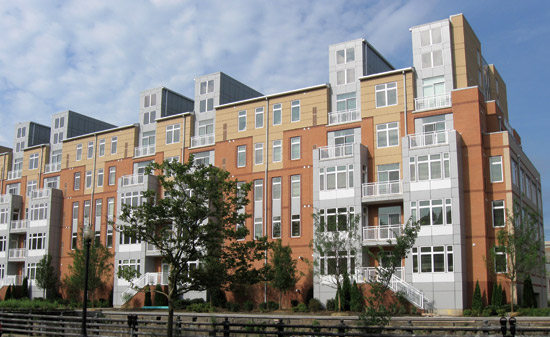Barrier vs. Rainscreen Exteriors
Similarly, capillary action—the movement of water caused by the surface tension between water drops—can be solved relatively easily with good design. The surface tension of water allows droplets to move together, or cohere. In porous materials, such as masonry, capillarity is usually the dominant force that causes wetting. Commonly known as “wicking,” water moves though masonry from one tiny pore to the next. The result is that the masonry stores this moisture, and, if enough mass is used, will have the capacity to hold enough water to prevent leaks through the wall. When the drying potential reverses (as happens when the sun comes out and warms the side of the building), the flow of water vapor reverses, explains Dr. John Straube of Building Science Corp. Masonry exteriors can be relatively forgiving, provided the mass is appropriate to the expected wetting conditions.
However, metal or glass panels are another matter altogether. Metal and glass don't absorb any water, but capillarity remains a concern at joints, where very small crevices create channels that can move large amounts of water against gravity. The droplets, in an effort to cohere, will literally push themselves upward through crevices in the cladding, and if they move far enough along a crevice, water can penetrate the interior of the structure.
One effective solution, that is often employed in some “dry seal” panel systems, is to create a capillary trap in the cladding joint—a gap that's large enough to break the surface tension so the water droplets no longer cohere. This gap needs to be drained so that when the surface tension is broken, the free-flowing water can drain away.
A capillary trap, however, is ineffective when the penetrating water is driven by air pressures that forcibly push and pull water and air through crevices in the façade. Whenever you have a difference in pressure—known as a pressure gradient—across a surface, you have an engine that forcibly moves liquid, be it air or water (or both, in the case of a rain storm). This force always moves from a region of higher pressure to a region of lower pressure.
 |
In Providence, Rhode Island, which sees over 45 inches of rainfall a year, composite metal panels proved to be good choice for the Capital Cove condominium project. Photo courtesy of Laminators Inc. |
Pressure gradients occur frequently and come from many sources. Wind pressure is the dominant source. It is considered a dynamic pressure, because it is constantly changing in intensity and direction as it flows around objects. But there are also static pressures that can have an effect on air and moisture flow. These include:
• Mechanical pressure. HVAC equipment inside the building can create positive and negative air pressures that act against the walls, pushing and pulling air through crevices that can draw water inwards or expel it to the exterior.
• Stack pressure. The pressure flow caused by the buoyancy of heated air turns a tall building into a chimney. Air flows from the bottom to the top. At the top, positive pressure pushes air out of the lid. Near the bottom of the building, negative pressure pulls outdoor air inside. This same principle can occur in a narrow chamber, like the gap between a cladding material and inner wall assembly. Imagine a 1-inch gap behind a veneer cladding. If this gap rises unobstructed for the height of a tall building, stack effect would create a determined flow of air. It would have a powerful drying effect, but might also tend to pull rain and moist air in behind the cladding down low, and push it out at the top.
Mechanical and stack pressures occur at fairly consistent and sustained levels, with only subtle variability in pressure. While these “static pressures” can move a lot of air through a building envelope when there are enough air leaks, the air pressures are relatively steady and can be effectively managed. Using impervious materials carefully installed to maintain air seals between layers of a wall assembly, the effect of static pressures on building airflow can be reduced to tolerable levels. Much more difficult to manage are the cyclic pressures induced by the wind.









